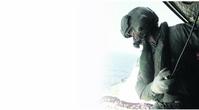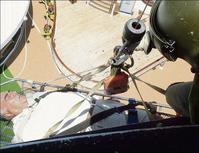
A JDF Air Wing soldier during a medical evacuation from the cruise ship Seven Seas Marina.
Today, we continue to spotlight those who have been nominated to receive the 2008 Gleaner Honour Award early next month at The Jamaica Pegasus hotel, New Kingston. In the category public service, the nominee is the Jamaica Defence Force.
When disaster strikes the nation, there is one agency that inevitably answers the call to get Jamaicans out of harm's way and back on their feet. The Jamaica Defence Force (JDF) has been leading the way in rescue missions for years and continues to be a literal lifesaver not just for Jamaicans, but also for persons from the entire region. Here is a bit of history, taken from the JDF website.
In 1962 when Jamaica gained Independence, one of the responsibilities that the new nation had to take on for itself was defence. It was quickly recognised that the newly formed JDF needed air support. The Jamaica Air Squadron was, therefore, formed in 1963 as a part of the Jamaica National Reserve by the then Chief of Staff Brigadier P.E. Crook, and became the first flying entity of the JDF.
First four pilots

The Jamaica Defence Force (JDF) hoists Joseph Vocaire, a patient, from the cruise ship Seven Seas Marina before flying him to the University Hospital of the West Indies on Sunday. The man's wife and nurse were also airlifted. The JDF Air Wing conducted the critical medical evacuation about 100 miles southeast of Jamaica. - Photos courtesy of the JDF Air Wing
Its first four pilots (Captains Garth Drew, Robert 'Bobby' Dixon, John Harrison and Jack Oliphant) were enlisted from the Jamaica Flying Club, all of whom had been commissioned Royal Air Force pilots.
On July 3, 1963, to assist with its rescue operations, the Air Wing was officially formed with Captain Victor Beek (on secondment from the Ministry of Education) as its first and only member. On July 9, 1963, Jamaica received four Cessna 185B aircraft through a Military Assistance Package from the US Government. These aircraft were painted white with blue trimmings, and had the national colours painted in bands over the wings. The first notable mission was flown on August 17, 1963, in search of a ganja boat registered as 'NANA'. It was not until September that the first enlisted soldier (Lance Corporal Scott) was posted to the unit as a driver, and hence became the first airman.
Because of how mountainous Jamaica is, it was soon realised that the JDF needed helicopters.
On October 11,1963, the first regular commanding officer arrived in Jamaica, Major Leslie Whittingham-Jones (along with his infamous dog 'Boots'). He was a British Army Air Corps (AAC) helicopter instructor pilot whose task was to train pilots and organise the Jamaica Air Wing. Shortly thereafter, the first helicopter (JDF H-1, a Bell 47G-3B-1) was delivered, and it was assembled in the JDF Workshop and pushed down the road to the Air Wing.
Dangerous mission
On May 17, 1967, Major Robert 'Bob' Neish and Lieutenant Andrew Bogle (who are the first JDF helicopter pilots) embarked on an extremely dangerous mission in the Blue Mountains to rescue a seriously injured soldier (Fusilier Hobbs). The area was so hilly and windy that the helicopter could not land, and during the ensuing rescue attempts, they lost control of the helicopter which resulted in them having to fly backwards in circles until they could conduct a safe run-on landing some 10 miles away with the patient safely aboard the aircraft. They were then able to tie the patient down and fly to a hospital. For this outstanding act of courage, skill and concentration, Major Neish was awarded the Air Force Cross, the highest flying award in the Commonwealth, and Lieutenant Bogle The Queen's Commendation for Valuable Service in the Air.
Since that historic mission, the JDF has flown tens of thousands of hours on countless missions, including flying members of the British monarch and several heads of states (including HRH Prince PHILLIP, and HRH Prince Charles). JDF through its Air Wing has flown countless search-and-rescue missions, transferring hundreds of critically injured patients across Jamaica, and from Grand Cayman and St Kitts, participated in the interdiction of hundreds of millions of US dollars worth of narcotics, and found many fishermen lost at sea.
Disaster relief

On August 10, Staff at the University Hospital of the West Indies rush one of the two men who were rescued by members of the Jamaica Defence Force Air Wing to the hospital's Accident and Emergency department. The men's aircraft went down in Portland on Friday. - Junior Dowie/Staff Photographer
The JDF has also provided disaster relief for thousands of Jamaicans during and after natural disasters; assisted in general elections in Haiti; moved thousands including soldiers, policemen, cameramen, journalists and athletes. It took parachutists, doctors and blood to Grand Cayman on Christmas morning in 1963; flown foreign investors, surveyors, town planners, VIPs and international personalities, including General Colin Powell, Johnnie Cochran, Patrick Ewing, Henry Kissinger and Lord Louis Mountbatten; as well as lifted special equipment into difficult areas. Several large government infrastructure projects have utilised the assets of the JDF, including the Yallahs Pipeline and the Hermitage Dam to name two.
From carrying one patient at a time in a wire basket hanging on the outside of the skid of a Bell 47G helicopter (with the wind blowing on them) and following railways lines into Kingston in 1963, to being able to winch six patients on stretchers into a Bell 412EP helicopter (while filming it with infrared equipment) and navigating through IFR conditions with 4-axis autopilot, EFIS, Doppler and a coloured weather radar in 2003, the JDF Air Wing has come a long way. The unit currently averages 2,100 flying hours per year. The Air Wing has proven its worth as an asset to the JDF and the nation under its motto 'We fly for all'.
Information taken from the JDF website.

